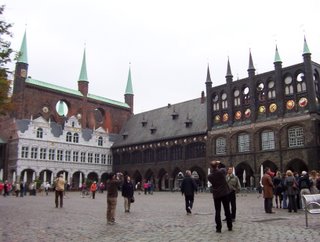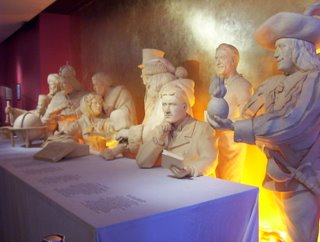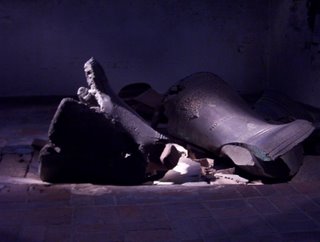Lübeck
My school (well all schools in the NRW, actually) is on a two week fall break, so I’ve decided to take a trip to see the sights of Northern Germany. First stop: Lübeck, former Hanseatic giant.
Lübeck is awesome. It reminds me a little of what San Francisco would be like if it had fewer hills and was a medieval German city: lots of pastel buildings, art galleries, and trendy cafes. There’s also a university here, so there are all kinds of young, artsy students wandering around. A guy I met in the hostel, for example, just started school here, and told me all about a mask he made out of meat (specifically pork).
Lübeck’s most famous sight is the Holstentor, which was under renovation when I was there, and so unfortunately was hidden behind a lot of scaffolding. Here’s a picture of the Rathaus, though, which literally made me say something like “holy crap,” out loud the first time I saw it.
 I also visited Café Niederegger, which is known for its marzipan confections, and has all kinds of crazy marzipan shapes you can buy: apples, carrots, potatoes, ham hocks, pig’s feet, etc. It also has a museum with these life-sized figures sculpted entirely from marzipan. Each figure represents an important aspect in the history of marzipan: a child, St. Nicholas, a nun, an apothecary, etc. I guess marzipan was originally used as medicine before it was considered candy. Yum!
I also visited Café Niederegger, which is known for its marzipan confections, and has all kinds of crazy marzipan shapes you can buy: apples, carrots, potatoes, ham hocks, pig’s feet, etc. It also has a museum with these life-sized figures sculpted entirely from marzipan. Each figure represents an important aspect in the history of marzipan: a child, St. Nicholas, a nun, an apothecary, etc. I guess marzipan was originally used as medicine before it was considered candy. Yum! One of my favorite parts of Lübeck was the Marienkirche, which is Germany’s third-largest church. I know, a church? But, yeah, really cool! Like many cathedrals, it’s huge and painted, and has neat stained glass windows, but it also has other things, too. These, for example, are the shattered church bells, which fell when the church was bombed during WWII and were left as a peace memorial.
One of my favorite parts of Lübeck was the Marienkirche, which is Germany’s third-largest church. I know, a church? But, yeah, really cool! Like many cathedrals, it’s huge and painted, and has neat stained glass windows, but it also has other things, too. These, for example, are the shattered church bells, which fell when the church was bombed during WWII and were left as a peace memorial.
This church also used to be the home of a famous Totentanz “death dance” frieze, which was painted during a plague epidemic. The frieze was huge and showed all kinds of community members: the bishop, the merchant, etc, dancing with death. Each section had a series of verses that went with it, and the basic idea was that, well, everyone dies, even the wealthy and the privileged, so have you prepared your soul? Here is a good German picture of what the frieze looked like, and for an English discussion of the piece, this is a pretty good site. Unfortunately the frieze was destroyed during the war. There’s a similarly-themed stained glass piece there now, but it’s not as exciting. I’m not sure why I loved this so much, but it’s really neat. Marienkirche also had a cool astronomical clock (with figures that spin around) and a really big mechanical organ, the world’s largest, in fact. I went to an organ concert they were having there, just to see, and well, it was really loud organ music, in a very, very cold church.
Okay, so maybe you’re tired of reading about Lübeck, but wait! There’s more. Lübeck is also connected to two Nobel Prize-winning authors, Günter Grass and Thomas Mann, and I visited both of their houses. The Günter Grass house has a collection of Grass’ drawings and sculptures, which are, I guess, an important part of his writing process, and were really impressive. They also had sections of each of the nine different drafts he went through in creating his recent book, Crabwalk. It was so cool to see all the different drafts: two handwritten, three typewritten, the rest word-processed. Apparently Grass still lives outside of town and comes to give talks and readings from time to time.
The Buddenbrookhaus (named after the title of Thomas Mann’s The Buddenbrooks, which I am reading now (in English). Wimpy, I know, but it’s 600 pages.) discusses not just the life of Thomas Mann, but also his brother, and his family, which was full of prodigies, like a real-life Royal Tenenbaums. Despite difficult lives of exile and tragedy, all of his six children were talented writers, actors, and/or musicians. One daughter even taught her dog how to read and to play duets on the piano with her. Just wait, Gromit.

0 Comments:
Post a Comment
<< Home